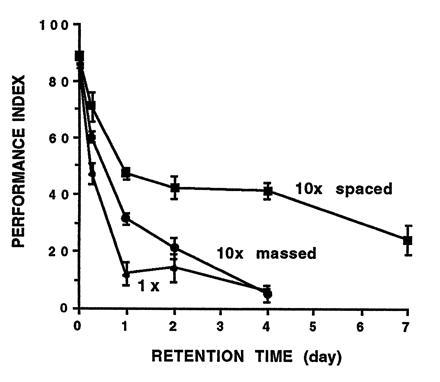Figure 3.

Memory retention after Pavlovian olfactory learning in fruit flies. During one training session (1×), about 100 flies were exposed sequentially to two odors (CSs) piped through the training chamber on air currents. During the first odor presentation, but not during the second, flies received 12 1-s pulses of footshock (US). Massed training (10× massed) consisted of 10 of these training sessions one after the other. Spaced training (10× spaced) consisted of 10 training sessions with a 15-min rest interval between each session. Conditioned odor avoidance responses were tested at various times after training by transferring the flies to the choice-point of a T-maze, where they were exposed to convergent currents of air carrying the odors used during training. Odor concentrations were adjusted for these conditioning experiments so that untrained flies distributed themselves 50:50. At most retention times after training, however, a majority of flies avoided the shock-paired odor. For a complete experiment, a second group of 100 flies was trained to the reciprocal odor combination. The performance index was an average of reciprocally trained groups and was calculated to be zero if flies distributed themselves 50:50 or 100 if all flies avoided the shock-paired odor. (Data from ref. 37; also see ref. 38 for more procedural details.)
